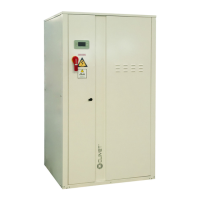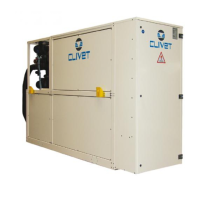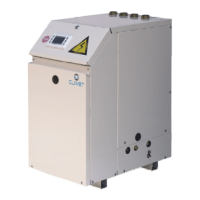Do you have a question about the CLIVET WSH-XSC3 and is the answer not in the manual?
Describes the manual's content and important warnings for unit operation.
States that only qualified personnel are permitted to operate the unit.
Highlights potential risks during operation and the need for qualified personnel.
Specifies the unit's intended purpose and limitations for safe operation.
Covers outdoor installation aspects, local regulations, and electrical checks.
Advises on planning periodic inspection and maintenance for optimal performance.
Warns that modifications void warranty and manufacturer responsibility.
Instructs on immediate deactivation and contacting authorized service agents.
Outlines essential training points for the user on unit operation and maintenance.
Advises checking the manufacturer's website for the latest product data.
Guides users on manual storage and procedures for requesting assistance.
Explains how to identify the unit using its serial number label and its features.
Identifies each unit uniquely and its importance for ordering spare parts.
Details how to request assistance by noting serial number data.
Advises observing external packaging instructions for proper unit storage.
Provides a step-by-step guide for safe unit handling and lifting operations.
Gives instructions for careful removal and disposal of unit packaging materials.
Defines functional spaces necessary for unit operation and maintenance access.
Details criteria for selecting installation locations and avoiding airflow issues.
Addresses the installer's responsibility for safety valve gas side considerations.
Refers to accessories for the installation of anti-vibration mount supports.
Specifies water quality requirements and potential issues from inadequate water.
Advises on methods to prevent freezing in water circuits during low temperatures.
Discusses the use of anti-freeze solutions and their effects on the system.
Defines the project water flow-rate requirements for correct operation.
Mentions minimum system water volumes needed to avoid compressor cycling.
Presents diagrams of hydronic assemblies for heating-only units.
Illustrates different types of hydraulic connections and their installation methods.
Provides diagrams of hydronic assemblies for cooling-only units.
Explains the function and installation requirements of the unit's flow switch.
Shows recommended hydraulic connection diagrams for various unit configurations.
Details the specifications and installation requirements for the water filter.
Lists the sequence of operations for system filling, cleaning, and leak testing.
Describes the option for partial energy recovery during cooling mode.
Explains parameter settings for a modulating 2-way valve for heat-only units.
Details parameter settings for a modulating 2-way valve for heat-only units.
Outlines parameter settings for a modulating 2-way valve for cooling-only units.
Describes parameter settings for a modulating 2-way valve for heat-only units.
Details parameter settings for an inverter pump on the user side for cooling.
Explains parameter settings for an inverter pump on the source side for heating.
Refers to further details regarding the NATURAL COOLING function.
Explains where to find unit specific electrical data on the serial number label.
Provides steps for making electrical connections and essential safety checks.
Gives guidelines for laying out signal and data cables to avoid interference.
Advises on fixing cables and avoiding contact with hot components during installation.
Details customer connections with a wiring diagram and component list.
Provides tables for power supply cable section and power bar specifications.
Explains how to use the remote ON-OFF function and necessary precautions.
Guides on connecting to the unit via PC and configuring network settings.
Details options and connections for various remote control devices.
Covers Modbus/RS485 communication, requirements, and cable specifications.
Explains LonWorks communication, cable types, and LED indicators.
Details BACnet IP communication, cable connections, and LED indicators.
Outlines general start-up procedures, responsibilities, and pre-checks.
Lists essential checks before unit power supply and initial start-up.
Describes the step-by-step sequence for powering and starting the unit.
Details checks for the refrigeration circuit, including oil stains and pressure.
Covers checks for the water circuit, including filling, pressurization, and air removal.
Guides on verifying electrical connections, conductor tightening, and phase balance.
Explains the connection and operation of compressor crankcase heaters.
Advises checking the connection and enabling of remote controls and optional components.
Guides on checking voltages and electrical absorptions during unit operation.
Explains how to limit absorbed electric power using an external 0-10V signal.
Details how to configure climatic temperature settings and related parameters.
Explains how water reset correction affects setpoints and its configuration.
Describes the ECOSHARE function for automatic management of multiple connected units.
Explains the different operation modes (A, B, C) for managing units in a network.
Details how to check evaporator water flow-rate and associated pressure drops.
Explains inverter-driven variable flow-rate control based on temperature differential.
Discusses scroll compressor rotation direction and necessary pressure checks.
Advises on potential damages from prolonged operation at reduced load.
Guides on identifying and recording operating conditions for unit monitoring.
Provides information on the 2014/68/UE PED directive for installations.
Explains the function and status of the INFO, ALARM, and CANCEL LEDs.
Describes the unit's display variables, such as date, time, and temperatures.
Lists the symbols and functions of the control panel keys for navigation.
Details how to change the unit's operating state (OFF, ECO, ON, Pump On).
Explains how to switch the unit's operating mode between Cooling and Heating.
Guides on modifying setpoint values for cooling, heating, and economic modes.
Explains how to set up scheduled events (Off, Eco, On) for each day of the week.
Describes how to view the unit's current operational status and machine state.
Details how to adjust keyboard and HMI settings for user interface customization.
Provides guidance on identifying causes, resetting, and managing unit alarms.
Lists various electrical circuit alarms, their numbers, descriptions, and categories.
Continues the list of electrical circuit alarms with their respective details.
Continues the list of electrical circuit alarms with their respective details.
Lists further electrical circuit alarms and the start of refrigerant circuit alarms.
Lists remaining refrigerant circuit alarms and the hydraulic circuit alarms.
Outlines the purpose and general procedures for performing unit maintenance.
Defines the frequency of inspections based on usage and provides a checklist.
Advises creating a unit booklet to record maintenance interventions and data.
Provides guidance on putting the unit into standby and re-starting it.
Emphasizes clean exchangers and outlines procedures for cleaning.
Lists checks for circulating pumps, including leaks and bearing status.
Advises checking the water filter for impurities that may obstruct water flow.
Mentions the flow switch's role and recommendations for its palette.
Lists the checks required for the crankcase heater operation.
Instructions regarding the compressor supply line shut-off valve seal.
Describes the advanced scroll temperature protection feature for compressors.
Advises checking the condition of unit insulations and renewing seals.
Provides instructions for system discharge and proper disposal of liquids.
Illustrates the step-by-step procedure for replacing a compressor.
Shows an illustration depicting the process for exchanger replacement.
Illustrates the procedure for replacing a unit pump.
Details antivibration mount types, codes, and dimensional specifications.
Illustrates the step-by-step installation procedure for antivibration mounts.
Explains the Natural Cooling function, its requirements, and activation conditions.
Provides instructions for disconnecting the unit and recovering refrigerants and fluids.
Guides on sending the unit to authorized centers for dismantling and disposal.
Explains the EC RAEE directive for proper disposal of electronic waste.
Lists common situations that pose risks to people or things during operation.
Warns about risks during handling operations without proper precautions.
Highlights risks associated with incorrect installation practices.
Covers general risks like component contact and unqualified maintenance.
Details risks related to electrical connections, sizing, and earthing.
Warns about injuries from contact with moving parts like fans and transmissions.
Covers risks associated with refrigerant, including leaks and thermal hazards.
Warns about risks from leaks or water projection from hydraulic components.
Presents performance data for cooling and heating modes across different unit sizes.
Details construction data for compressors, exchangers, and electrical components.
Presents sound power and pressure levels for super-silenced and basic configurations.
Displays operating range charts for cooling only and heating only units.
Lists minimum and maximum admissible water flow-rates for correct unit operation.
Lists calibration values for various overload and control devices.
Shows dimensional drawings and specifications for the super-silenced EN configuration.
Continues dimensional drawings for the super-silenced EN configuration for larger sizes.
Shows dimensional drawings for the basic BN configuration for smaller sizes.
Continues dimensional drawings for the basic BN configuration for larger sizes.
Describes the manual's content and important warnings for unit operation.
States that only qualified personnel are permitted to operate the unit.
Highlights potential risks during operation and the need for qualified personnel.
Specifies the unit's intended purpose and limitations for safe operation.
Covers outdoor installation aspects, local regulations, and electrical checks.
Advises on planning periodic inspection and maintenance for optimal performance.
Warns that modifications void warranty and manufacturer responsibility.
Instructs on immediate deactivation and contacting authorized service agents.
Outlines essential training points for the user on unit operation and maintenance.
Advises checking the manufacturer's website for the latest product data.
Guides users on manual storage and procedures for requesting assistance.
Explains how to identify the unit using its serial number label and its features.
Identifies each unit uniquely and its importance for ordering spare parts.
Details how to request assistance by noting serial number data.
Advises observing external packaging instructions for proper unit storage.
Provides a step-by-step guide for safe unit handling and lifting operations.
Gives instructions for careful removal and disposal of unit packaging materials.
Defines functional spaces necessary for unit operation and maintenance access.
Details criteria for selecting installation locations and avoiding airflow issues.
Addresses the installer's responsibility for safety valve gas side considerations.
Refers to accessories for the installation of anti-vibration mount supports.
Specifies water quality requirements and potential issues from inadequate water.
Advises on methods to prevent freezing in water circuits during low temperatures.
Discusses the use of anti-freeze solutions and their effects on the system.
Defines the project water flow-rate requirements for correct operation.
Mentions minimum system water volumes needed to avoid compressor cycling.
Presents diagrams of hydronic assemblies for heating-only units.
Illustrates different types of hydraulic connections and their installation methods.
Provides diagrams of hydronic assemblies for cooling-only units.
Explains the function and installation requirements of the unit's flow switch.
Shows recommended hydraulic connection diagrams for various unit configurations.
Details the specifications and installation requirements for the water filter.
Lists the sequence of operations for system filling, cleaning, and leak testing.
Describes the option for partial energy recovery during cooling mode.
Explains parameter settings for a modulating 2-way valve for heat-only units.
Details parameter settings for a modulating 2-way valve for heat-only units.
Outlines parameter settings for a modulating 2-way valve for cooling-only units.
Describes parameter settings for a modulating 2-way valve for heat-only units.
Details parameter settings for an inverter pump on the user side for cooling.
Explains parameter settings for an inverter pump on the source side for heating.
Refers to further details regarding the NATURAL COOLING function.
Explains where to find unit specific electrical data on the serial number label.
Provides steps for making electrical connections and essential safety checks.
Gives guidelines for laying out signal and data cables to avoid interference.
Advises on fixing cables and avoiding contact with hot components during installation.
Details customer connections with a wiring diagram and component list.
Provides tables for power supply cable section and power bar specifications.
Explains how to use the remote ON-OFF function and necessary precautions.
Guides on connecting to the unit via PC and configuring network settings.
Details options and connections for various remote control devices.
Covers Modbus/RS485 communication, requirements, and cable specifications.
Explains LonWorks communication, cable types, and LED indicators.
Details BACnet IP communication, cable connections, and LED indicators.
Outlines general start-up procedures, responsibilities, and pre-checks.
Lists essential checks before unit power supply and initial start-up.
Describes the step-by-step sequence for powering and starting the unit.
Details checks for the refrigeration circuit, including oil stains and pressure.
Covers checks for the water circuit, including filling, pressurization, and air removal.
Guides on verifying electrical connections, conductor tightening, and phase balance.
Explains the connection and operation of compressor crankcase heaters.
Advises checking the connection and enabling of remote controls and optional components.
Guides on checking voltages and electrical absorptions during unit operation.
Explains how to limit absorbed electric power using an external 0-10V signal.
Details how to configure climatic temperature settings and related parameters.
Explains how water reset correction affects setpoints and its configuration.
Describes the ECOSHARE function for automatic management of multiple connected units.
Explains the different operation modes (A, B, C) for managing units in a network.
Details how to check evaporator water flow-rate and associated pressure drops.
Explains inverter-driven variable flow-rate control based on temperature differential.
Discusses scroll compressor rotation direction and necessary pressure checks.
Advises on potential damages from prolonged operation at reduced load.
Guides on identifying and recording operating conditions for unit monitoring.
Provides information on the 2014/68/UE PED directive for installations.
Explains the function and status of the INFO, ALARM, and CANCEL LEDs.
Describes the unit's display variables, such as date, time, and temperatures.
Lists the symbols and functions of the control panel keys for navigation.
Details how to change the unit's operating state (OFF, ECO, ON, Pump On).
Explains how to switch the unit's operating mode between Cooling and Heating.
Guides on modifying setpoint values for cooling, heating, and economic modes.
Explains how to set up scheduled events (Off, Eco, On) for each day of the week.
Describes how to view the unit's current operational status and machine state.
Details how to adjust keyboard and HMI settings for user interface customization.
Provides guidance on identifying causes, resetting, and managing unit alarms.
Lists various electrical circuit alarms, their numbers, descriptions, and categories.
Continues the list of electrical circuit alarms with their respective details.
Continues the list of electrical circuit alarms with their respective details.
Lists further electrical circuit alarms and the start of refrigerant circuit alarms.
Lists remaining refrigerant circuit alarms and the hydraulic circuit alarms.
Outlines the purpose and general procedures for performing unit maintenance.
Defines the frequency of inspections based on usage and provides a checklist.
Advises creating a unit booklet to record maintenance interventions and data.
Provides guidance on putting the unit into standby and re-starting it.
Emphasizes clean exchangers and outlines procedures for cleaning.
Lists checks for circulating pumps, including leaks and bearing status.
Advises checking the water filter for impurities that may obstruct water flow.
Mentions the flow switch's role and recommendations for its palette.
Lists the checks required for the crankcase heater operation.
Instructions regarding the compressor supply line shut-off valve seal.
Describes the advanced scroll temperature protection feature for compressors.
Advises checking the condition of unit insulations and renewing seals.
Provides instructions for system discharge and proper disposal of liquids.
Illustrates the step-by-step procedure for replacing a compressor.
Shows an illustration depicting the process for exchanger replacement.
Illustrates the procedure for replacing a unit pump.
Details antivibration mount types, codes, and dimensional specifications.
Illustrates the step-by-step installation procedure for antivibration mounts.
Explains the Natural Cooling function, its requirements, and activation conditions.
Provides instructions for disconnecting the unit and recovering refrigerants and fluids.
Guides on sending the unit to authorized centers for dismantling and disposal.
Explains the EC RAEE directive for proper disposal of electronic waste.
Lists common situations that pose risks to people or things during operation.
Warns about risks during handling operations without proper precautions.
Highlights risks associated with incorrect installation practices.
Covers general risks like component contact and unqualified maintenance.
Details risks related to electrical connections, sizing, and earthing.
Warns about injuries from contact with moving parts like fans and transmissions.
Covers risks associated with refrigerant, including leaks and thermal hazards.
Warns about risks from leaks or water projection from hydraulic components.
Presents performance data for cooling and heating modes across different unit sizes.
Details construction data for compressors, exchangers, and electrical components.
Presents sound power and pressure levels for super-silenced and basic configurations.
Displays operating range charts for cooling only and heating only units.
Lists minimum and maximum admissible water flow-rates for correct unit operation.
Lists calibration values for various overload and control devices.
Shows dimensional drawings and specifications for the super-silenced EN configuration.
Continues dimensional drawings for the super-silenced EN configuration for larger sizes.
Shows dimensional drawings for the basic BN configuration for smaller sizes.
Continues dimensional drawings for the basic BN configuration for larger sizes.
| Refrigerant | R134a |
|---|---|
| Acoustic Configuration | Low noise |
| Power Supply | 400V/3Ph/50Hz |
| Compressor Type | Screw |
| Heat Recovery | Available as option |











